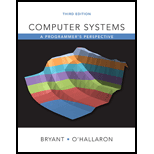
A.
Given code:
//Include necessary header files
#include <stdio.h>
#include "csapp.h"
//Define a main function
int main()
{
//Variable declaration
int status;
pid_t pid;
//Print the statement
printf("Hello\n");
//Call the method fork() and assign it to the variable pid
pid = fork();
//Print the statement
printf("%d\n",!pid);
//Check, pid is not equal to zero
if (pid != 0)
{
//True, check the condition
if (waitpid(-1, &status, 0) > 0)
{
//True, check the condition
if (WIFEXITED(status) != 0)
//True, print the statement
printf("%d\n" , WEXITSTATUS(status));
}
}
//Otherwise, print the statement
printf("Bye\n");
//Exit
exit(2);
}
Explanation:
The given code is used to print the number of output lines and possible outputs.
In the given code, the variable “status” and “pid_t pid” are declared.
- The main program first print the output line “Hello”.
- Then, call the function “fork()”, which is called once and return twice.
- Print the value that is not equal to the variable “pid”.
- The “if” condition check, the variable “pid” is not equal to “0”.
- True, “if” condition check, “(waitpid(-1, &status, 0) > 0)”.
- True, “if” condition check, “(WIFEXITED(status) != 0)”.
- True, print the value of “WEXITSTATUS(status)”.
- True, “if” condition check, “(WIFEXITED(status) != 0)”.
- True, “if” condition check, “(waitpid(-1, &status, 0) > 0)”.
- Print the statement “Bye”.
- Exit from the program.
B.
Explanation of Solution
Possible ordering of the output lines:
Possible output sequence corresponding to the process graph is as follows:
Hello
Want to see the full answer?
Check out a sample textbook solution
Chapter 8 Solutions
Computer Systems: A Programmer's Perspective Plus Mastering Engineering With Pearson Etext -- Access Card Package (3rd Edition)
- Describe three (3) Multiplexing techniques common for fiber optic linksarrow_forwardCould you help me to know features of the following concepts: - commercial CA - memory integrity - WMI filterarrow_forwardBriefly describe the issues involved in using ATM technology in Local Area Networksarrow_forward
- For this question you will perform two levels of quicksort on an array containing these numbers: 59 41 61 73 43 57 50 13 96 88 42 77 27 95 32 89 In the first blank, enter the array contents after the top level partition. In the second blank, enter the array contents after one more partition of the left-hand subarray resulting from the first partition. In the third blank, enter the array contents after one more partition of the right-hand subarray resulting from the first partition. Print the numbers with a single space between them. Use the algorithm we covered in class, in which the first element of the subarray is the partition value. Question 1 options: Blank # 1 Blank # 2 Blank # 3arrow_forward1. Transform the E-R diagram into a set of relations. Country_of Agent ID Agent H Holds Is_Reponsible_for Consignment Number $ Value May Contain Consignment Transports Container Destination Ф R Goes Off Container Number Size Vessel Voyage Registry Vessel ID Voyage_ID Tonnagearrow_forwardI want to solve 13.2 using matlab please helparrow_forward
- a) Show a possible trace of the OSPF algorithm for computing the routing table in Router 2 forthis network.b) Show the messages used by RIP to compute routing tables.arrow_forwardusing r language to answer question 4 Question 4: Obtain a 95% standard normal bootstrap confidence interval, a 95% basic bootstrap confidence interval, and a percentile confidence interval for the ρb12 in Question 3.arrow_forwardusing r language to answer question 4. Question 4: Obtain a 95% standard normal bootstrap confidence interval, a 95% basic bootstrap confidence interval, and a percentile confidence interval for the ρb12 in Question 3.arrow_forward
 C++ for Engineers and ScientistsComputer ScienceISBN:9781133187844Author:Bronson, Gary J.Publisher:Course Technology Ptr
C++ for Engineers and ScientistsComputer ScienceISBN:9781133187844Author:Bronson, Gary J.Publisher:Course Technology Ptr Operations Research : Applications and AlgorithmsComputer ScienceISBN:9780534380588Author:Wayne L. WinstonPublisher:Brooks Cole
Operations Research : Applications and AlgorithmsComputer ScienceISBN:9780534380588Author:Wayne L. WinstonPublisher:Brooks Cole C++ Programming: From Problem Analysis to Program...Computer ScienceISBN:9781337102087Author:D. S. MalikPublisher:Cengage Learning
C++ Programming: From Problem Analysis to Program...Computer ScienceISBN:9781337102087Author:D. S. MalikPublisher:Cengage Learning New Perspectives on HTML5, CSS3, and JavaScriptComputer ScienceISBN:9781305503922Author:Patrick M. CareyPublisher:Cengage Learning
New Perspectives on HTML5, CSS3, and JavaScriptComputer ScienceISBN:9781305503922Author:Patrick M. CareyPublisher:Cengage Learning Systems ArchitectureComputer ScienceISBN:9781305080195Author:Stephen D. BurdPublisher:Cengage Learning
Systems ArchitectureComputer ScienceISBN:9781305080195Author:Stephen D. BurdPublisher:Cengage Learning Fundamentals of Information SystemsComputer ScienceISBN:9781305082168Author:Ralph Stair, George ReynoldsPublisher:Cengage Learning
Fundamentals of Information SystemsComputer ScienceISBN:9781305082168Author:Ralph Stair, George ReynoldsPublisher:Cengage Learning





